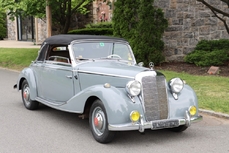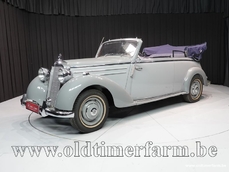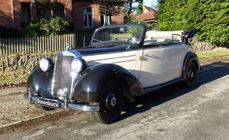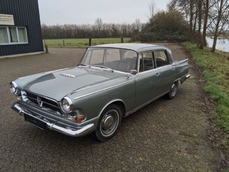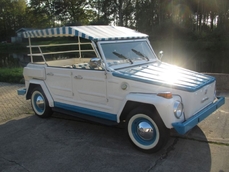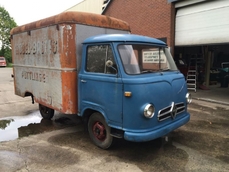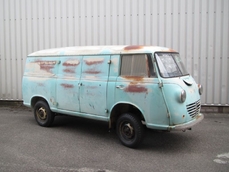Mercedes-Benz 170S S Cabrio B 1950
General description :
Informationen auf Deutsch
Weitere Informationen
Türenzahl: 2
Zylinderzahl: 4Informatie in het Nederlands
Opmerkingen
Dit is een mooie ongerestaureerde, super originele auto uit een grote Mercedes verzameling afkomstig uit Californië.
De Mercedes-Benz 170 S is een luxeauto die van 1949 tot 1955 door Mercedes-Benz werd geproduceerd in verschillende vormen op benzine en diesel. Het werd aanvankelijk aangeboden met een 1,8 liter-versie van de 1,7 liter inline-viercilinder M136-motor gebruikt in de iets kleinere productietype 170 V. Het was de eerste Mercedes-Benz die in zijn naam het achtervoegsel "S" droeg (voor Sonder modell (Speciaal model), wat duidt op een superieur niveau van comfort en kwaliteit, waardoor de beoogde markt succesvolle bedrijfseigenaren en bedrijfsdirecteuren was. De 170 S werd uitgebracht in mei 1949, waarbij het chassisnummer van de W136 170 V in eerste instantie werd gedeeld en het In veel opzichten sterk op leek was het echter meer een ontwikkeling van de zescilinder Mercedes-Benz 230 die het bedrijf had geproduceerd tussen 1938 en 1943.
--
Dies ist ein schönes unrestauriertes, super originelles Auto aus einer großen Mercedes-Sammlung aus Kalifornien.
Der Mercedes-Benz 170 S ist ein Luxusauto, das Mercedes-Benz von 1949 bis 1955 in verschiedenen Formen auf Benzin und Diesel produziert. Es wurde zunächst mit einer 1,8-Liter-Version des 1,7-Liter-Reihenvierzylindermotors M136 angeboten, der in der etwas kleineren Serienversion 170 V zum Einsatz kam. Es war der erste Mercedes-Benz, der in seinem Namen das Suffix "S" trug. (für Sondermodell), das ein überlegenes Maß an Komfort und Qualität anzeigt, den beabsichtigten Markt erfolgreicher Unternehmer und Firmenchefs macht. Der 170 S wurde im Mai 1949 veröffentlicht, wo zunächst die Fahrgestellnummer des W136 170 V erschien wurde geteilt und in vieler Hinsicht eher wie eine Weiterentwicklung des Sechszylinders Mercedes-Benz 230, den das Unternehmen zwischen 1938 und 1943 produziert hatte.
This is a beautiful unrestored, super original car from a large Mercedes collection from California.
The Mercedes-Benz 170 S is a luxury car which was produced by Mercedes-Benz from 1949 until 1955 in various gasoline and diesel powered forms. It was initially offered with a 1.8 liter version of the 1.7 liter inline-four cylinder M136 engine used in the slightly smaller production type 170 V. It was the first Mercedes-Benz to carry in its name the suffix S (for Sonder modell (Special model) denoting a superior level of comfort and quality. As such, its intended market was successful business owners and company directors. The 170 S was released in May 1949, initially sharing the chassis number of the W136 170 V, and closely resembled it. However, in several respects it was more directly a development from the six cylinder Mercedes-Benz 230 wh...
1950 Mercedes-Benz 170S S Cabrio B is listed for sale on ClassicDigest in Ettensestraat 19NL-7061 AA Terborg by POTOMAC CLASSICS B.V. for €85000.
Car Facts
Car type : Car Make : Mercedes-Benz Model : 170S Model Version : S Cabrio B Engine size : 1.8 Model Year : 1950 Sub type : Convertible Location : Ettensestraat 19NL-7061 AA Terborg Vehicle Registration : Undefined
85000 €
People who viewed this Mercedes-Benz 170S also viewed similar Mercedes-Benz listed at ClassicDigest
Other cars listed for sale by this dealer
About Mercedes-Benz
In the annals of automotive history, the journey of Mercedes-Benz is a tale that unfolds with the ingenuity of its founding pioneers. In the year 1886, Karl Benz crafted the Benz Patent Motorwagen, a creation that would go down in history as the world's inaugural automobile. Unbeknownst to him, this moment marked the genesis of what would evolve into the most illustrious premium car manufacturer globally. The financial underpinning of this pioneering venture, interestingly, was provided by Karl Benz's wife, Bertha Benz, demonstrating a remarkable partnership that would set the tone for Mercedes-Benz's legacy.A parallel narrative emerged not far away, as Daimler-Motoren-Gesellschaft, founded by Gottlieb Daimler and Wilhelm Maybach, entered the scene. In 1901, they unveiled their automobile under the now-famous moniker "Mercedes," meaning "godsend" in Spanish. This name was bestowed upon the car at the behest of Emil Jellinek's daughter, the distributor for Daimler-Motoren-Gesellschaft. The wheels of innovation were set in motion.
Fast forward to 1926, a pivotal year that witnessed the merger of Daimler with Benz & Cie., culminating in the birth of Daimler-Benz. The amalgamation saw the adoption of "Mercedes-Benz" as the distinguished trademark for their automobiles, fusing the legacies of two visionary entities into one.
Contrary to perceptions of conservatism, the trajectory of Daimler-Benz unfolds as a chronicle of industry firsts. From the introduction of the honeycomb radiator to the float carburetor, and the pioneering implementation of four-wheel brakes in 1924, Daimler-Benz consistently pushed the boundaries of automotive innovation. The diesel-powered Mercedes-Benz 260 D in 1936 marked the inception of diesel engines in passenger cars. The iconic Mercedes-Benz 300SL Gullwing made history as the first car with direct fuel injection, albeit the Gutbrod's tiny 2-stroke engine can claim precedence.
Safety innovations became a hallmark, with Béla Barényi's patented safety cell design in the "Ponton"-models in 1951, featuring front and rear crumple zones. The W116 450SEL 6.9 saw the introduction of the Anti-Lock Brake system (ABS), another pioneering safety feature. From the first production airbags and beyond, the legacy of "firsts" continued to be etched into the fabric of Daimler-Benz.
Over its centennial journey, Mercedes-Benz has not merely produced cars but has sculpted automotive icons. The SSKL, 710 SSK Trossi Roadster, 770K Grosser, 540K Spezial Roadster, 300SL Gullwing, w100 600 Pullman, w111 280SE 3.5 Flachkühler, w113 230SL Pagoda, w109 300 SEL 6.3, and w201 2.3-16 Cosworth stand testament to the brand's commitment to engineering excellence.
The roaring Silver Arrows, or "Silberpfeile," including the W 25, W 125, W154, W165, and W196, created a legacy of dominance on the racetrack. These machines were not merely cars; they were expressions of precision, speed, and an indomitable spirit that left their competitors in the dust.
As Mercedes-Benz marches into the future, it does so not just as an automaker but as a custodian of a legacy, a torchbearer of innovation, and a beacon of automotive excellence. The road ahead is sure to witness the continued fusion of cutting-edge technology, timeless design, and an unwavering commitment to setting new standards in the world of automobiles.
One luminary figure who left an indelible mark was Béla Barényi, often heralded as the "father of passive safety" for his pioneering work in safety engineering. His patented safety cell design, featuring front and rear crumple zones, became a hallmark of Mercedes-Benz's commitment to occupant safety, setting new standards that reverberated throughout the automotive world.
Moving through the chronicles, the collaborative genius of Wilhelm Maybach, alongside Gottlieb Daimler, laid the foundation for Daimler-Motoren-Gesellschaft. Their innovations not only birthed the first Mercedes but established a culture of relentless pursuit of technological excellence that remains integral to Mercedes-Benz's DNA.
In the post-merger era of 1926, Ferdinand Porsche emerged as a prominent figure within Mercedes-Benz. His work on the Mercedes-Benz S-Type, a supercharged race car, garnered acclaim and set the stage for a legacy that extended far beyond the marque. Porsche's impact would later extend to his eponymous company, but his influence at Mercedes-Benz during those formative years was pivotal.
As the 20th century progressed, the legendary Rudolf Uhlenhaut emerged as a key figure. Uhlenhaut, an accomplished engineer and the driving force behind the iconic Silver Arrows, played a crucial role in Mercedes-Benz's dominance in motorsports. His engineering prowess and attention to detail were instrumental in creating some of the most formidable racing cars of the era.
In the latter half of the century, figures like Bruno Sacco, the head of design at Mercedes-Benz from 1975 to 1999, left an indelible imprint on the brand's aesthetic identity. Sacco's design philosophy, characterized by clean lines and timeless elegance, shaped iconic models like the W126 S-Class and the W201 190E, solidifying Mercedes-Benz's reputation for luxury and sophistication.
The narrative would be incomplete without acknowledging the contributions of engineers like Hans Scherenberg, whose leadership in the 1970s ushered in a new era of technological innovation at Mercedes-Benz. Scherenberg's tenure saw the development of groundbreaking technologies, including the Anti-Lock Brake system (ABS) and the introduction of airbags in production cars.
















